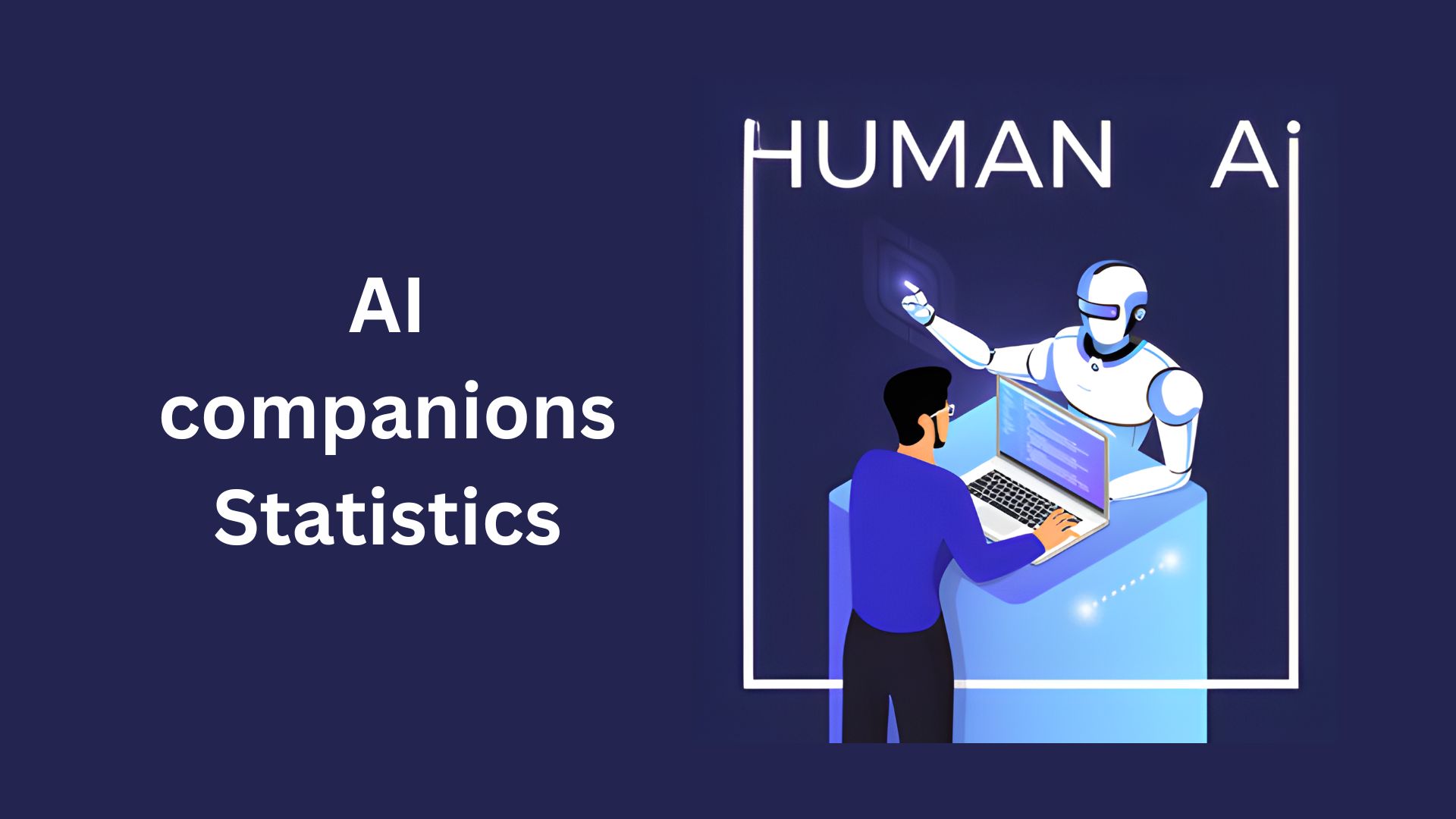Data Engineering Statistics By Job Market, Startup, Trends And Facts (2025)
Updated · Sep 08, 2025

Table of Contents
- Introduction
- Editor’s Choice
- General Data Engineering Statistics
- Data Engineering Service Market Statistics
- Educational Background Required to Become a Data Engineer
- Required Degrees in Data Engineering Job Postings
- Data Engineering Job Postings Statistics by Required Skills Statistics
- By Programming Languages
- 365 data science
- By Data Analysis Skills
- Data Engineering Job Postings Statistics by Location
- Data Engineering Job Market Statistics
- Salary Analysis of Data Engineering Role Statistics
- Total Data Generated by Engineers
- Data Engineering Trends
- Innovative Data Engineering Startups Statistics
- Conclusion
Introduction
Data Engineering Statistics: Data engineering is all about building, maintaining, and improving systems that collect, store, and process information. The purpose is to keep data accurate, well-organised, and easy to access. Data engineering process used in analysing business performance, training AI models, and guiding smart organisational decisions.
Industries like retail, healthcare, finance, and manufacturing depend on large volumes of data to boost efficiency, enhance productivity, and drive innovation. With advances in cloud computing, AI, automation, and edge technology, data engineering has evolved into a key force powering innovation, better governance, and sustainable growth for the future.
Editor’s Choice
- According to Mordor Intelligence, the global market size of big data engineering services is estimated to reach USD 91.54 billion.
- Startus-insights.com states that data engineering now employs over 150,000 people worldwide, with more than 20,000 new professionals joining in the past year.
- Leading hubs shaping the industry include the United States, India, the United Kingdom, Germany, and the Netherlands.
- The market size of Data Engineering as a Service (DaaS) is predicted to reach USD 13.2 billion by 2026 from USD 5.4 billion in 2023.
- Similarly, data engineering focused on social good has the potential to generate USD 3.9 trillion annually in the same period.
- As of 2024, Data Engineering emerges as the most sought-after qualification, appearing in 49.4% of postings, as mentioned in 365datascience.com.
- Besides, about 79.4% of data engineering job ads require SQL skills like MySQL or PostgreSQL.
- SQL is the most widely used skill in data engineering, with a 79.4% share.
- Out of a total of 703 job postings for data engineers, originating from 576 companies across 37 U.S. states, the largest share came from remote positions, accounting for 71 postings or 10.1%.
- storage.googleapis.com shows that in 2025, data engineering is expected to be one of the fastest-growing roles, with a 35% increase in demand.
- As of 2024, 8.8% of data engineers earn between USD 120,000 and USD 160,000, as per a Glassdoor analysis.
- According to ascend.io, in the last year, 83% of data engineers said AI and new tools made them more productive, the highest in five years.
- A report published by Start Us Insights depicts that the global data engineering landscape currently features 1,554 startups.
General Data Engineering Statistics
- A study by Flexera shows that cloud technology has become very popular, with 94% of companies already using it in their operations.
- Gartner predicts that by the near future, 75% of businesses will use artificial intelligence (AI) and machine learning (ML) combined with data engineering.
- Indeed projects that the median salary for data engineers in the United States could reach about USD 170,000 by 2026.
- A major talent gap is expected in the data engineering field, with nearly 2.9 million job openings worldwide for data-related roles.
- Technavio forecasts that the market for data lakes and large storage systems will grow to USD 20.04 billion by 2028.
- Cloud data warehouses, which store data in the cloud, are becoming more popular, reaching USD 33.2 billion by the end of 2027.
- Outsourcing data engineering work is increasing rapidly, with a projected compound annual growth rate of 10.2% between 2023 and 2028.
- According to Databricks, 87% of these teams rely on open-source tools (used by data engineers) because they are flexible and cost-effective.
- O’Reilly Media reports that 42% of companies are either planning to adopt or are already using innovative data engineering methods.
- Gartner predicts that by 2025, 10% of large companies will use quantum computing for specific data engineering tasks.
- In the coming years, 20% of data engineering tasks will be handled using serverless technologies.
- IDC forecasts that by 2026, about 75% of data engineering processes will be partially or fully automated, improving efficiency.
- According to EMA, 78% of organisations are actively planning or using DataOps practices.
- Cybersecurity spending worldwide is expected to reach USD 10.5 trillion between 2023 and 2030, according to Cybersecurity Ventures.
- Job postings for specialised data engineering positions have risen by 35% year-over-year, as reported by Indeed.
Data Engineering Service Market Statistics
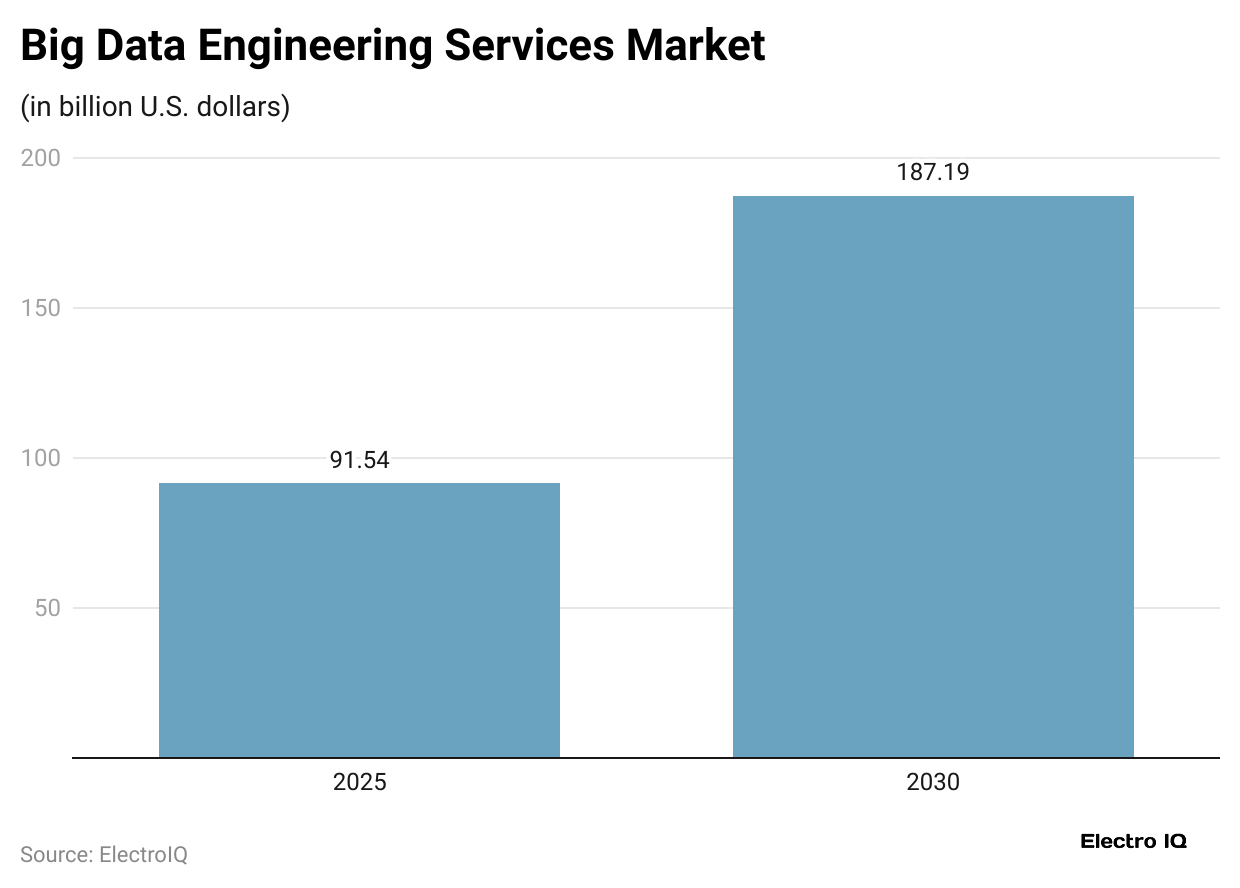
- The above graph reports that the global market size of big data engineering services is estimated to reach USD 91.54 billion.
- By the end of 2030, the market will grow to around USD 187.19 billion, with a CAGR of 15.38% from 2025 to 2030.
Educational Background Required to Become a Data Engineer
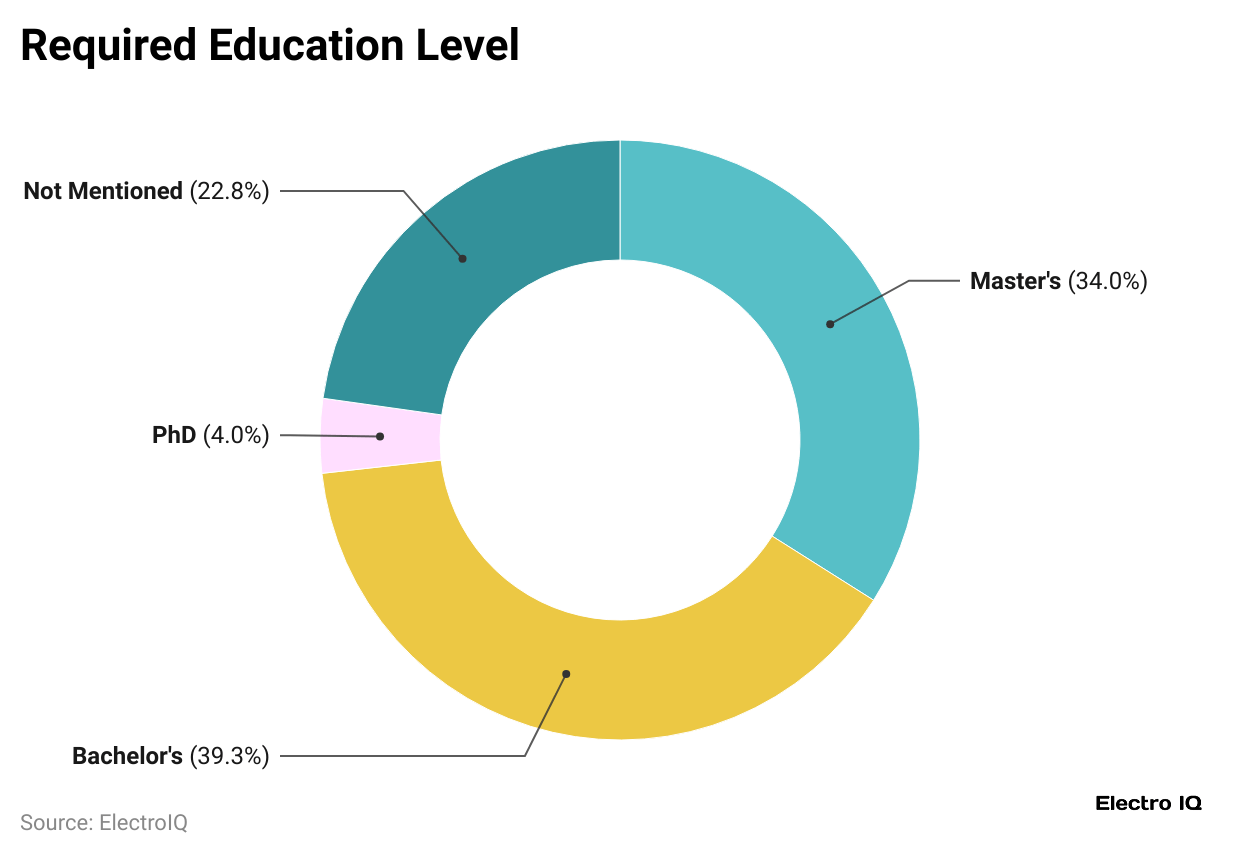
- The graph shows that about 39.3% of data engineer job ads look for candidates with a bachelor’s degree, 34% ask for a master’s, and only 4% require a PhD.
- In contrast, nearly 23% of the postings do not mention any specific degree requirement.
Required Degrees in Data Engineering Job Postings
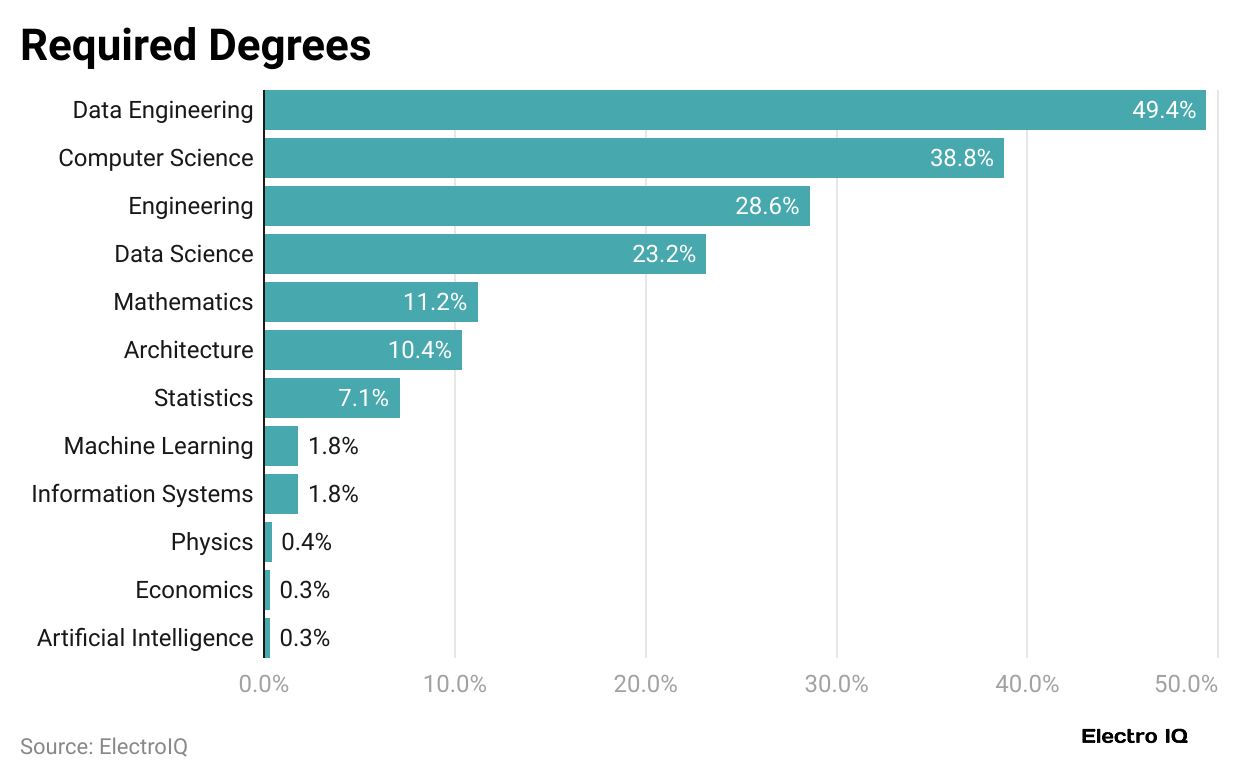
- As of 2024, Data Engineering emerges as the most sought-after qualification, appearing in 49.4% of postings.
- This is followed by Computer Science at 38.8% and General Engineering at 28.6%.
- Data Science degrees are also in strong demand, with 23.2% of listings referencing them, followed by Mathematics (11.2%), Architecture (10.4%), and Statistics (7.1%), which hold mid-range demand.
- Specialised fields such as Machine Learning and Information Systems are mentioned in 1.8% of postings each, while Physics (0.4%), Economics (0.3%), and Artificial Intelligence (0.3%) appear less frequently.
Data Engineering Job Postings Statistics by Required Skills Statistics
- According to 365datascience.com, about 79.4% of data engineering job ads require SQL skills like MySQL or PostgreSQL.
Furthermore, other data engineering skills are mentioned in the table below:
| Skills | Share |
| Azure |
74.5% |
|
Extract, Transform and Load (ETL) |
56.8% |
| Apache Spark |
41.1% |
|
Data Lake |
25.9% |
| Data Modeling |
23.9% |
|
Hadoop |
17.8% |
| Apache Kafka |
16.2% |
|
Data Pipelines |
14.8% |
| NoSQL |
12.1% |
|
Snowlake |
11.7% |
| Docker |
9% |
|
Hive |
8.4% |
| Amazon Redshift |
6.1% |
|
Big Data |
5.1% |
| Data Governance |
5% |
|
Data Integration |
4.1% |
| Relational Databases |
3.6% |
|
Apache Airflow |
3.3% |
| BigQuery |
3.3% |
|
Graph Databases |
3.3% |
| Others |
5.4% |
By Programming Languages
- According to 365 Data Science, SQL is the most widely used skill in data engineering, with a 79.4% share, as it is essential for working with relational databases, running queries, and managing structured data.
- Python follows closely with a 73.7% share, valued for its simple syntax, powerful libraries, and versatility in data processing, manipulation, and machine learning.
- Java (22.6%) and Scala (17.5%) are important in big data environments, especially with Apache Hadoop and Apache Spark.
- R holds 14.9% due to its strength in statistical analysis and visualisation.
- JavaScript, with a 3.4% share, is mainly used for building web-based data visualisations, integrating APIs, and managing data in browser applications.
365 data science
| Skill | Share |
| Microsoft Azure | 74.5% |
| AWS (Amazon Web Services) | 49.5% |
| GCP (Google Cloud Platform) | 21.3% |
| Docker | 9% |
| Kubernetes | 6.7% |
| Salesforce | 2.8% |
By Data Analysis Skills
| Skill | Share |
| Data Visualization | 12.8% |
| Data Mining | 4.6% |
| SAS | 3.3% |
| Statistical Analysis | 2.4% |
| Predictive Modeling | 1.0% |
| Exploratory Data Analysis | 0.6% |
| A/B Testing | 0.4% |
| Regression Analysis | 0.1% |
| Time Series Analysis | 0.1% |
| Hypothesis Testing | 0.1% |
By Artificial Intelligence (AI) & Machine Learning (ML) Skills
| AI Skill | Share | ML Skill | Share |
| Machine learning | 29.9% | Optimization Algorithms | 16.9% |
| APIs | 13.7% | Natural Language Processing (NLP) | 2% |
| Artificial Intelligence (AI) | 11% | Feature Engineering | 1.1% |
| Natural Language Processing (NLP) | 2% | Clustering | 1.1% |
| Deep Learning | 0.9% | Computer Vision | 1.1% |
| Prompt Engineering | 0.3% | Deep Learning | 1.1% |
| Reinforcement Learning | 0.1% | Predictive Modeling | 1% |
| Anomaly Detection | 1% | ||
| Decision Trees | 0.3% | ||
| Linear Regression | 0.1% | ||
| Artificial Neural Network (ANN) | 0.1% | ||
| Reinforcement Learning | 0.1% | ||
| Unsupervised Machine Learning | 0.1% |
Data Engineering Job Postings Statistics by Location
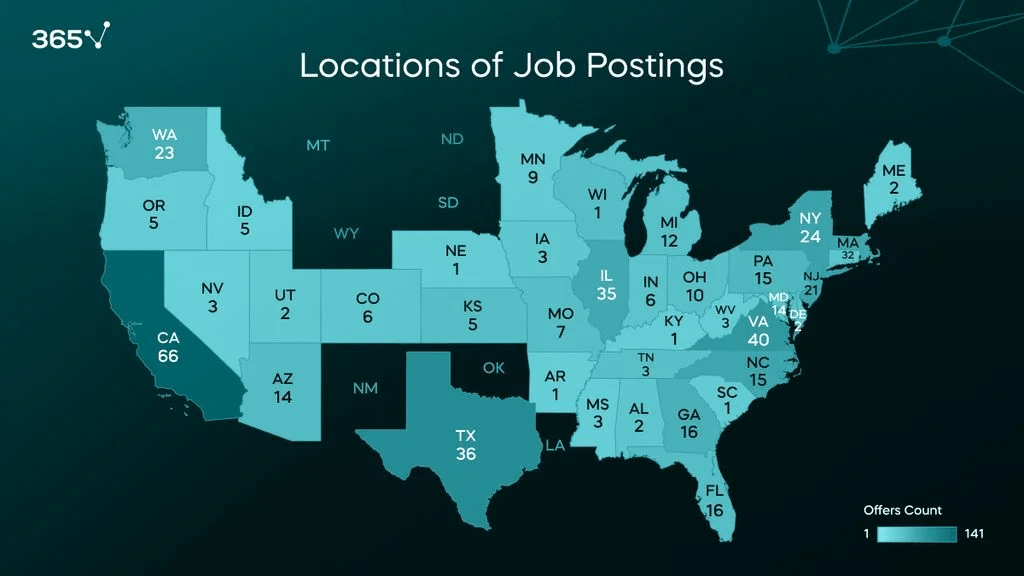
- Out of a total of 703 job postings for data engineers, originating from 576 companies across 37 U.S. states, the largest share came from remote positions, accounting for 71 postings or 10.1%.
- California followed closely with 66 postings (9.4%), while Virginia contributed 40 postings (5.7%).
- Texas and Illinois had 36 (5.1%) and 35 (5.0%) postings, respectively.
- Massachusetts posted 32 jobs (4.6%), and New York had 24 (3.4%).
- Washington reported 23 postings (3.3%), New Jersey had 21 (3.0%), and both Georgia and Connecticut each accounted for 16 postings, representing 2.3% of the total.
Data Engineering Job Market Statistics
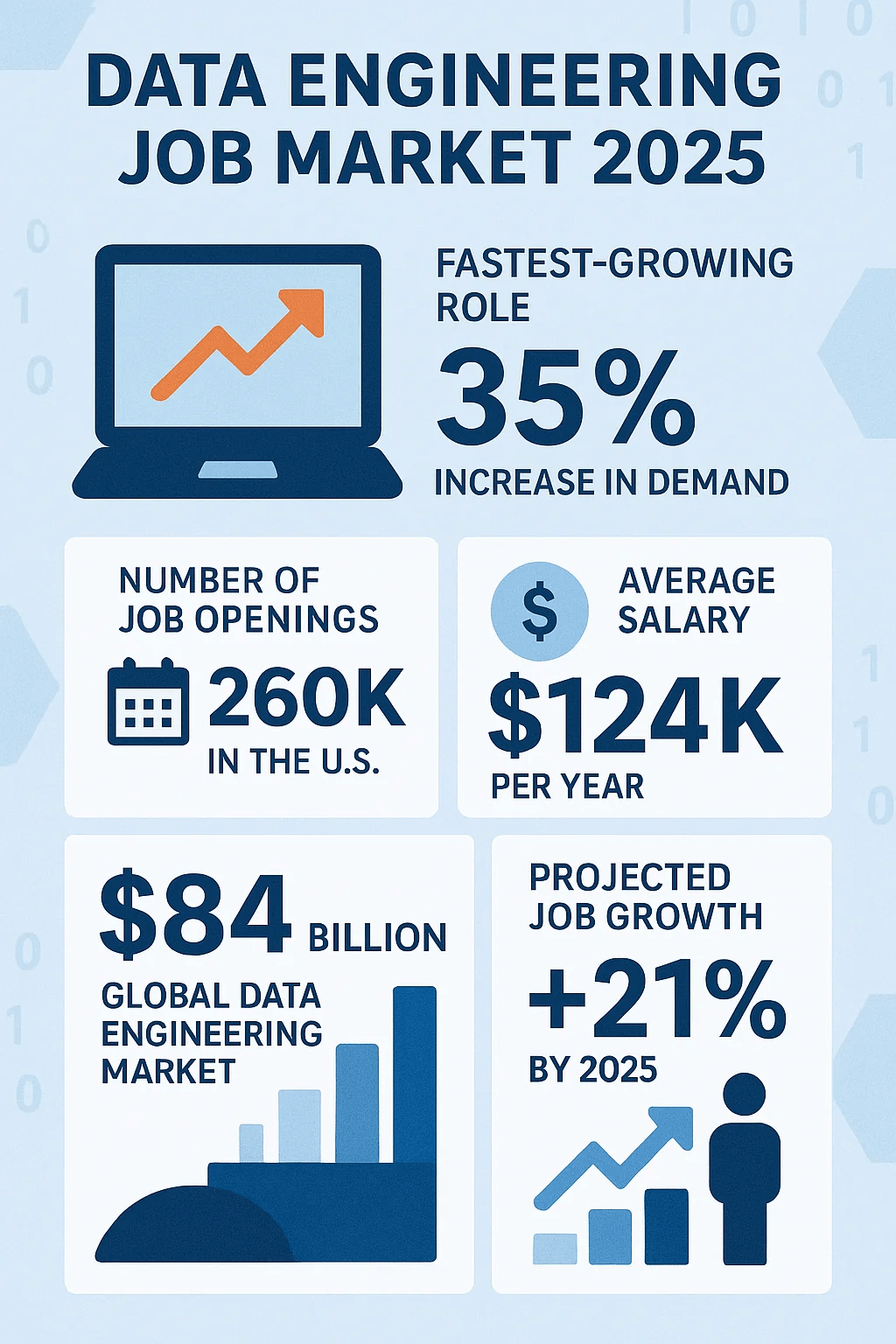
- In 2025, data engineering is expected to be one of the fastest-growing roles, with a 35% increase in demand.
- The United States alone is projected to have around 260,000 job openings in this field.
- The average annual salary for data engineers is estimated at USD 124,000.
- Globally, the data engineering market is projected to reach USD 84 billion.
- Job growth in this sector is also forecasted to climb by 21% by 2025, especially for professionals pursuing careers in data engineering.
Salary Analysis of Data Engineering Role Statistics
- As of 2024, only 1.4% of Data Engineer professionals earned salaries between USD 60,000 and USD 80,000, while 3.8% between USD 80,000 and USD 100,000, according to the reports of Glassdoor.
- A larger share, 7.7% of engineers, is between USD 100,000 and USD 120,000, and the highest proportion, 8.8% is between USD 120,000 and USD 160,000.
- Salaries ranging from USD 160,000 to USD 200,000 attract 2.7% of respondents, and 1.7% earn above USD 200,000.
The total yearly salary for data engineering positions in 2024, categorised by experience level.
| Years | Annual Salary |
| 0 to 1 | USD 91K to USD 155K/yr |
| 1 to 3 | USD 102K to USD 173K/yr |
| 4 to 6 | USD 112K to USD 189K/yr |
| 7 to 9 | USD 114K to USD 193K/yr |
| 10 to 14 | USD 117K to USD 201K/yr |
| 15+ | USD 130K to USD 225K/yr |
Total Data Generated by Engineers
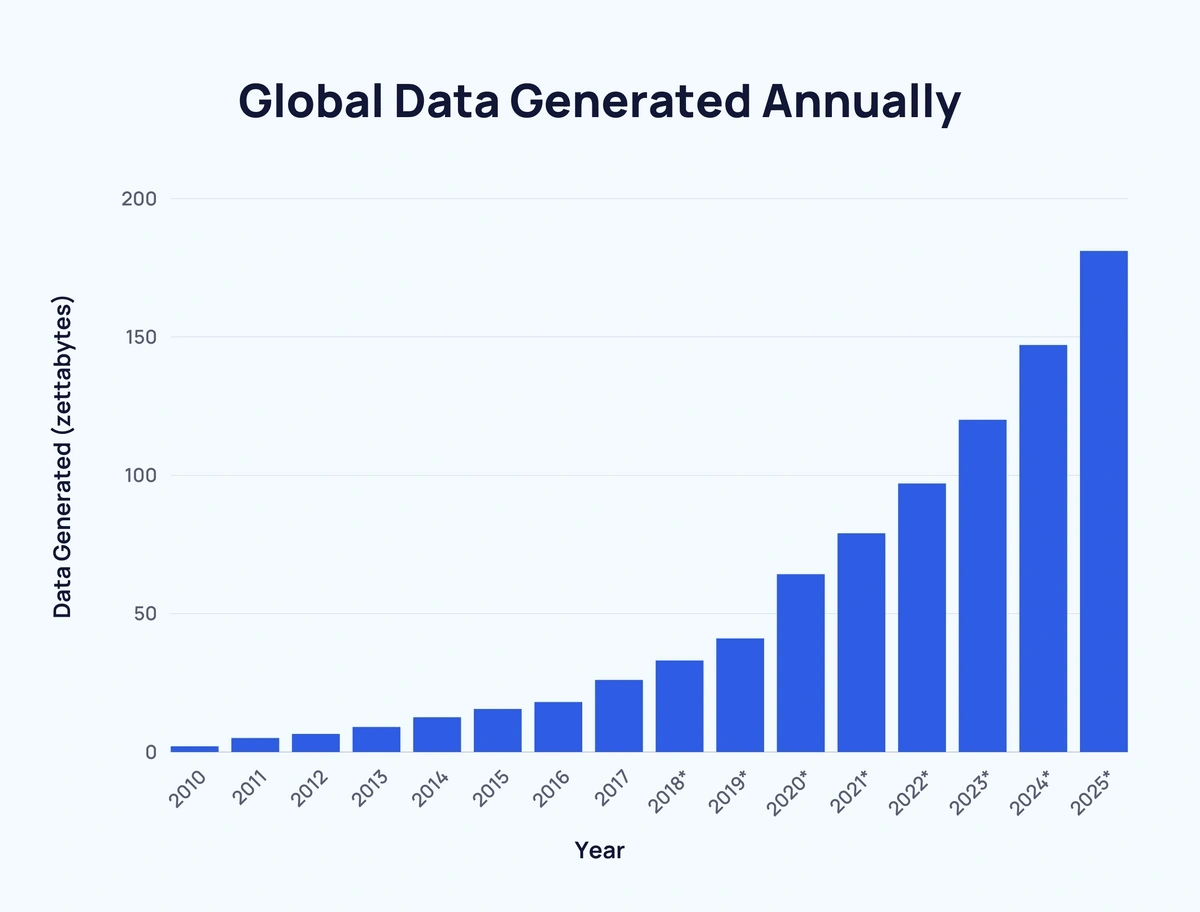
| Year | Data Generated (zettabytes) | Change Rate (YoY) |
| 2025 | 181 | +23.13% |
| 2024 | 147 | +22.5% |
| 2023 | 120 | +23.71% |
| 2022 | 97 | +22.78% |
| 2021 | 79 | +23.05% |
| 2020 | 64.2 | +56.59% |
Data Engineering Trends
- According to ascend.io, in the last year, 83% of data engineers said AI and new tools made them more productive, the highest in five years.
- Yet, over 95% feel they are at or over their work limit, with 24% heavily overloaded.
- Meanwhile, 69% believe hiring is too slow for growing data needs.
- Nearly half of the participants ranked boosting team productivity among their top three goals, making it 11% more important than any other area.
- To achieve this, 85% plan to adopt data automation tools within a year.
- However, despite strong interest, only 5% have used such technologies so far.
- A recent survey shows that 89% of people use generative AI in some way, with 47% applying it for test automation, 44% for code generation, and 40% for documentation.
- However, about one-third of individual workers still don’t use AI in their tasks, and nearly 20% of startup teams have no plans to adopt it within a year.
Innovative Data Engineering Startups Statistics
- A report published by Start Us Insights depicts the global data engineering landscape currently featuring 1,554 startups, with innovative companies like dEX from Brazil, PurpleCube AI from the USA, Quantaleap from the Netherlands, IOBlend from the UK, and Polypheny from Switzerland making a mark in data engineering.
- Together, they hold more than 60 patents and have secured over 100 grants, showing their strong progress in technology and research.
- In the past year, data engineering grew by 22.89%, reaching over 1,500 startups.
- Around 130 are new, and 80 joined through mergers or acquisitions.
- The industry holds 60+ patents, led by China and followed by the United States.
Conclusion
To sum it up, data engineering has become an important part of today’s data-focused world, helping organisations collect, handle, and use information in smarter ways. With technology improving quickly, more skilled professionals joining the field, and startups bringing fresh ideas, its role is spreading across many industries. As the need for strong and scalable data systems grows, data engineering will keep shaping business plans, supporting the progress of AI, and pushing digital change forward worldwide.
Sources
FAQ.
The three main types of data engineers are generalist, pipeline-centric, and database-centric
The hardest part of data engineering is managing complex, large-scale data pipelines while ensuring accuracy, reliability, scalability, and security.
The four V’s of data engineering represent volume, velocity, variety, and veracity, resulting in data’s size, speed, types, and accuracy.
The stages include data collection, storage, processing, transformation, integration, quality assurance, modelling, and delivering insights.

Maitrayee Dey has a background in Electrical Engineering and has worked in various technical roles before transitioning to writing. Specializing in technology and Artificial Intelligence, she has served as an Academic Research Analyst and Freelance Writer, particularly focusing on education and healthcare in Australia. Maitrayee's lifelong passions for writing and painting led her to pursue a full-time writing career. She is also the creator of a cooking YouTube channel, where she shares her culinary adventures. At Smartphone Thoughts, Maitrayee brings her expertise in technology to provide in-depth smartphone reviews and app-related statistics, making complex topics easy to understand for all readers.









